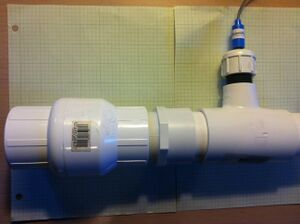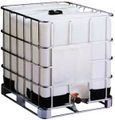
The Water Meter is a water quality meter designed by the Cal Poly Humboldt Engineering 215 - Intro to Design class and implemented on the WetLand mobile habitat.
Background[edit | edit source]
WetLand is a mobile self-sustainable island-based ecosystem started in summer of 2014 on a barge located on the Delaware River in Philadelphia, PA. The goal of WetLand is to offer a workspace for artists; a stage for forums on our shared future; and to combine art, life on the water, architecture, and environmental technologies.
Objective[edit | edit source]
The water meter is designed to monitor the volume, flow, and quality of water which is collected and stored on the WetLand habitat. Water on the WetLands habitat is collected through desalination of water from the Delaware river and through rainwater catchment. This water is filtered for use onboard, but requires monitoring to insure its quality for use.
Criteria[edit | edit source]
| Criteria | Constraint |
|---|---|
| Budget | less than 400.00 |
| Reliability | Must be reliable. |
| Safe | Must pose no threat to the occupants of the WetLands barge. |
| Aesthetics | Must look concise and simple. |
| Durability | Must with stand weather and day to day use by the passengers. |
| Maintainability | Easily maintained and accessed |
| Reproducibility | Has the ability to be reproduced by using the design plans |
| Ease of Use | Able to be used by the everyday citizen |
| Power Consumption | Consumes as little power as possible |
Design[edit | edit source]
The water meter, designed by Team X, tests the water quality for the WetLand project. The design is composed of five sensors that read the volume, pH, salt water content via conductivity, temperature (Fahrenheit), and the flow of the water into the water tank of the drinking water on the barge. All of the values the sensors take are read by an Arduino programmable microchip and displayed on a liquid crystal display (LCD) screen. While displaying these values it will be saving those values to an SD card that is incorporated into the Arduino microchip.
- components of the water meter
-
The flow meter
-
The IBC Tote
-
The sonar sensor
-
A section of the sampling compartment with the pH sensor integrated
-
The pH sensor
-
The saline sensor
-
The temperature sensor
-
The Arduino
-
The sensor shield
-
The SD card shield
-
The LCD screen
Flow Meter[edit | edit source]
The flow meter is to be placed at the inlet of the water take so the amount of water the barge is taking on is known in liters/hour. Another flow meter will be placed near the outlet and used to trigger the monitoring system to test quality of water while being the water is being pumped through the pipes.
Intermediate Bulk Container (IBC) Tote[edit | edit source]
The IBC tote is where the water for the WetLand habitat is stored. The tank can hold a total of 275 gallons.
Volume Sensor[edit | edit source]
The volume sensor is an ultrasonic ping sensor. The sensor emits ultrasonic sound waves that bounces of the water in the tank and reflects back to the sensor. From the time it takes to be emitted and the time it takes to return to the sensor depends on how far away the water is from the sensor. using a conversion factor that varies depending on the distance the volume is calculated and displayed to the LCD screen. All measurements will be displayed in gallons.
pH Sensor[edit | edit source]
The pH sensor is an Atlas pH sensor that tests for acidity or basicity of the water in the tank. This sensor MUST be constantly stored in water or else it will break and need to be replaced. Also this sensor needs to be calibrated approximately once a week because it is constantly being stored in the testing solution and will need to be cleaned; however, if it is not being constantly used it can be stored and may last up to a year with out being calibrated.
Saline Sensor[edit | edit source]
The saline sensor is derived from a small volume/conductivity sensor. The probe will read a conductivity value and through a conversion find the parts per million of the salt concentration on the barge.
Temperature[edit | edit source]
The temperature sensor is used to display the temperature of the water when it is being stored. This will be displayed in Fahrenheit.
Arduino[edit | edit source]
The entire system runs off of an Arduino Uno programmable microchip. The Arduino is programmed with a specific code located here. Due to the limited amount of input pins on the Arduino a sensor shield is incorporated to expand the amount of sensors that can be utilized.
LCD Screen[edit | edit source]
The LCD screen is where all of the data that is read and calculated by the Arduino is displayed. This is designed to be easy to read and comprehend. the reader should right away know if that water they have is potable or if it needs to further be purified.
Data Shield[edit | edit source]
The Data Storage Shield uses an SD or micro SD memory card to track and store data trends that are being measured by each sensor. The data stored here can be saved and allow the inhabitants of the barge to see how the water is over time.
Costs[edit | edit source]
Material costs:
| Material | Cost ($) |
|---|---|
| Arduino Uno Microchip | 25.00 |
| LCD Screen | 11.00 |
| Sensor Shield | 10.00 |
| Salinity Sensor | 9.00 |
| Temperature Sensor | 6.50 |
| pH Sensor | 112.00 |
| Flow Rate Sensor(2) | 24.00 |
| Data Storage Shield | 8.50 |
| Sonar Sensor | 5.50 |
| Wiring | 12.00 |
| Plumbing | 47.00 |
| Redwood Electronic soldering | 10.00 |
| Total | 271.50 |
Instructions[edit | edit source]
The instructions on how to build the water meter can be found here: WetLand water meter instructions
The code for the Arduino can be found here: Team X Water Meter Arduino Code
Video[edit | edit source]
Conclusions[edit | edit source]
Team X has designed a water meter to test for volume, flow into the storage tank, pH, salinity, and temperature that is displayed on an easy to read LCD screen all while allowing the inhabitants of the barge to track the water over time on an SD card. While there are other water quality monitoring systems out on the market, the water meter designed by Team X is relatively inexpensive when compared to other comparable systems such as Extech's WQ510 water quality meter that is listed at $629.00. The water meter designed by Team X for the WetLand Project has fulfilled the criteria as laid out above
Maintenance[edit | edit source]
This system is designed to have easy access to the sensors. The pH and saline sensors will need to be cleaned of debris once a week. This is a result of being constantly submerged in the water. The pH sensor must be wet at all times and cannot dry out because the pH sensor will break and need to be replaced. To prevent this, the pH sensor should be stored in a buffer solution if the sensor is not being used. To clean off debris a soft brush such as a toothbrush can be used to brush off the buildup.

References[edit | edit source]
- (15 Aug. 2012.) "Crystalline Silicon Photovoltaics Research." SunShot Initiative:
http://www1.eere.energy.gov/solar/sunshot/pv_crystalline_silicon.html (02 Oct. 2013.)
- (1998). Food Equipment Materials. American National Standard/NSF International Standard,
January, 1-5.
- (2010). "River Facts" Delaware Riverkeeper Network,
- (2011) "Operating Systems" http://en.wikipedia.org/wiki/Operating_system
- (2013) "Arduino." <http://www.arduino.cc/ > (2013)
- (2013) "programming language)" <http://en.wikipedia.org/wiki/C_(programming_language)>
(2013)
- (2013) Stroustrup B. "The C++ Programming Language." Addison Wesley Longman, Inc.
<http://en.wikipedia.org/wiki/Java_(programming_language)> (2013)
- (Aug. 11, 2013). "Dirty Rainwater and Contaminated Rainwater." Tankworks,
<http://web.archive.org/web/20150311105426/http://watertactics.com.au/blog/rainwater/dirty-rainwater-and-contaminated-rainwater/> (Aug. 11, 2013).
- (Dec. 4, 2012). "Water Treatment"
<http://www.cdc.gov/healthywater/drinking/public/water_treatment.html> (Dec. 4, 2012).
- (Field, Simon.) "Electrochemistry -- Make Homemade Batteries." Chapter 3: Electrochemistry
-- Make Homemade Batteries in Your Kitchen. <http://scitoys.com/scitoys/scitoys/echem/batteries/batteries.html> (02 Oct. 2013.)
- "National Water-Quality Assessment Program." USGS,
<http://web.archive.org/web/20130515012605/http://nj.usgs.gov/nawqa/delr/reports/fs-056-99.pdf>
- "NOAA Forecasts Larger Than Normal "Dead Zone" for Gulf This Summer." NOAA,
<http://web.archive.org/web/20180614181106/http://www.noaanews.noaa.gov:80/stories2006/s2669.htm>.
- Anonymous (2007) "Beginning AutoCAD 2007"
- Brain, M. (n.d.). How Water Towers Work. December 10, 2013,
http://www.howstuffworks.com/water.htm
- Chapman, Peter. (Nov. 3, 2009). "Assessing Sediment Contamination in Estuaries." Wiley
Online Library, <http://onlinelibrary.wiley.com/doi/10.1002/etc>(Nov. 3, 2009).
- Downey, N. (2010). Harvest the rain: how to enrich your life by seeing every storm as a
resource. Santa Fe, N.M.: Sunstone Press.
- Energy Star (2013). "LCD Basics" <http://www.energystar.gov/index.cfm?c=monitors.lcd>
(2013)
- Evision, L., & Sunna, N. (2001). Microbial Regrowth in Household Water Storage Tanks.
American Water Works Association, 93(9), 85-94.
- FDA Food Code 2009: Chapter 5 - Water, Plumbing & Waste. (n.d.). December 10, 2013,
http://www.fda.gov/Food/GuidanceRegulation/RetailFoodProtection/FoodCode/ucm186352.ht m
- Gibbons, Jack; Whit, Jones; Root, Ellen; Schwarz, Bessie. (Nov. 22, 2004). "Rainwater
- Chemistry Across the United States."
<http://web.archive.org/web/20181222232521/https://people.carleton.edu/~bhaileab/environmentalgeology/RainWater.pdf>(Nov. 22, 2004).
- Hambrice, K. (2004, December 1). A Dozen Ways to Measure Fluid Level and How They
Work. Sensors. Retrieved December 11, 2013. http://www.sensorsmag.com/sensors/leaklevel/ a-dozen-ways-measure-fluid-level-and-how-they-work-1067
- Heath, Alan. (1995). Water Pollution and Fish Physiology, 2nd Ed., CRC Press, Florida.
- "Indoor water use in the United States" EPA. Retrieved December 10, 2013, from
http://www.epa.gov/WaterSense/pubs/indoor.html
- Karre, A (2005) "The complete Guide to home wiring" Creative Publishing International,
Minneapolis, Minnesota
- Lewis ZL, Douglas GP, Monaco V, Crowley RS, 2010) "Touchscreen task efficiency and
learnability in an electronic medical record at the point-of-care" Magnet (2013) "Alternating Current" <http://www.magnet.fsu.edu/education/tutorials/java/ac/index.html> (2013)
- Lowe, Mary (2005). 3D Printing. Appliance Design, October, 35-39.
- Nordblom, O., & Bergdahl, L. (2004). Initiation of Stagnation in Drinking Water Storage Tanks.
Journal of Hydraulic Engineering, 130(1), 49-57.
- Plastic Water Tank Design Considerations and Specifications. (n.d.). December 10, 2013,
http://web.archive.org/web/20131208033128/
- Scott, C.(2012). "HC-SR04 Ultrasonic Sensor" Arduino Basics
http://arduinobasics.blogspot.com/2012/11/arduinobasics-hc-sr04-ultrasonicsensor. html>(2012).
- Veraart, R. (n.d.). www.foodcontactmaterials.com; the free legislative internet resource for
food contact materials. December 10, 2013, http://www.foodcontactmaterials.com/
Contact details[edit | edit source]
Solomon Clark: skc224@humboldt.edu
Peter Duin: pad177@humboldt.edu
Javier Hinojosa: jh2593@humboldt.edu
Matthew Small: mas1311@humboldt.edu











